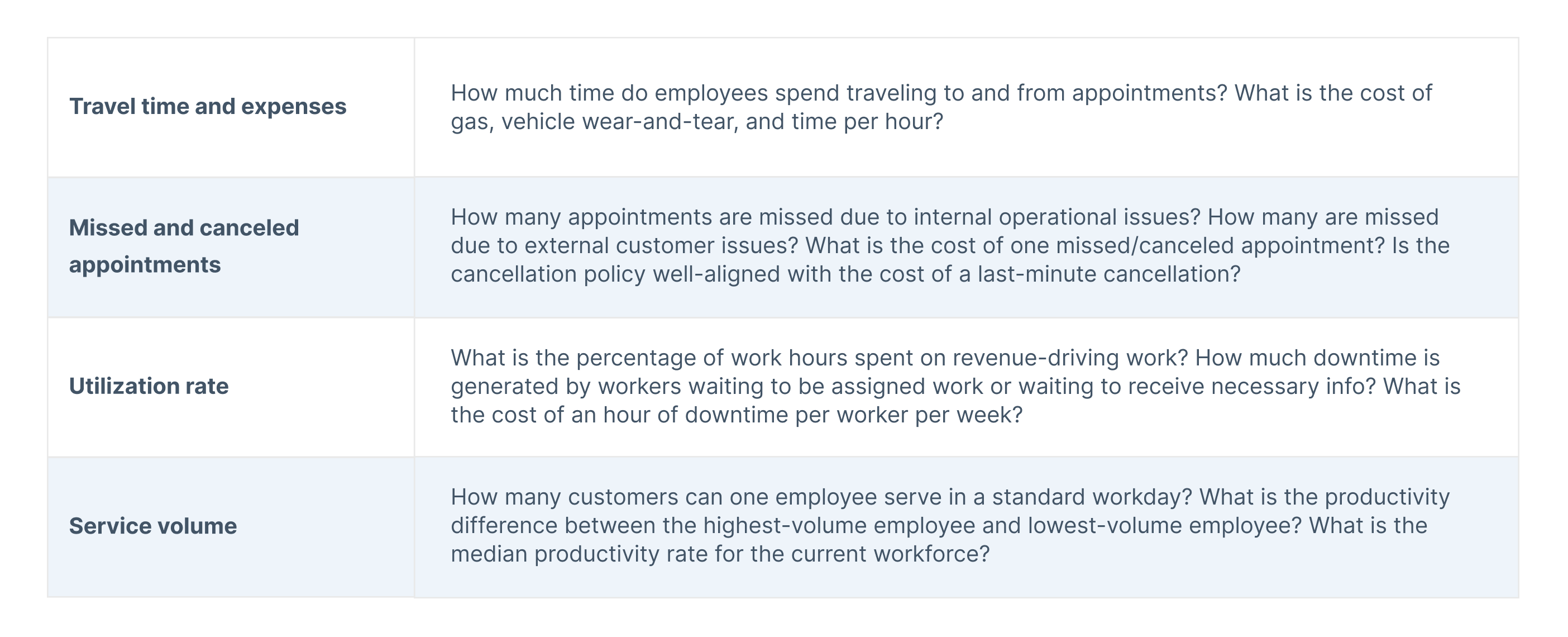How Employee Scheduling Affects Revenue
When it comes to revenue strategy, employee scheduling matters more than you might think. Scheduling helps control operational costs, improve the employee experience, increase resource utilization, and improve customer interactions.
With the right scheduling strategy—and some technology to support the team—companies can use scheduling to unlock revenue opportunities in several areas:
01. Operational expenses
02. Customer service
03. Workforce hiring, retention, and satisfaction
04. Calculate the ROI of efficient scheduling
05. Make scheduling a competitive advantage
01. Operational expenses
The cost of doing business—e.g. labor, equipment, fuel, and facilities expenses—is key to the revenue equation. Across regions and industries, C-suite executives named cost management as their top priority for 2024.
Staff scheduling and expenses are closely linked. To control costs, workers need to maximize time spent on revenue-driving and minimize time spent on redundant or administrative tasks. Here are four ways that scheduling relates to operational costs:
Travel costs
Scheduling goes hand in hand with optimizing travel routes. The ideal schedule is a logical sequence of appointments without unnecessary travel, maximizing the time available for work and minimizing the time spent on the road between jobs. This results in lower fuel costs, more jobs completed per day, more accurate appointment times, and more satisfied customers. Minimizing travel time is especially important in fields like utilities maintenance that depend on traveling to customers’ locations.
Administrative work
Workforce scheduling software can streamline and automate common scheduling tasks, requiring less time from administrative staff. Schedulers, dispatchers, and managers can automatically assign straightforward jobs based on predefined criteria. When a complex job arises, they can quickly narrow down a large list of workers to a small subset of qualified workers within a certain travel range who are available at the right time. This scheduling efficiency frees up staff time to handle unique requests and grow the business in other ways.
Invoice accuracy
Manual, inefficient scheduling can drag down other areas of the business. When the scheduling process is handled via spreadsheets or a whiteboard, the invoicing process—just a step later—becomes harder to manage. With a smart scheduling system, companies can automatically generate and send invoices after the appointment based on the work performed. (In some cases, field workers can collect signatures and payment during the appointment itself.) This scheduling, billing, and CRM integration makes invoicing more accurate and more timely—a huge step for operational efficiency.
Staff utilization rate
More efficient scheduling means workers can accomplish more per day. Billable hours divided by the employee’s total working hours (multiplied by 100) is the workforce utilization rate. Company leaders can work toward higher utilization rates through smart scheduling strategies, efficient travel routes, and user-friendly processes for common tasks—including handling schedule changes.
How does it relate to revenue?
- Better travel routes = lower fuel costs and less vehicle wear and tear
- Efficient scheduling = higher utilization rates, more revenue-driving work
- More accurate invoicing = more predictable revenue cycles, faster payments
Spreadsheet scheduling and manual invoices introduce costly delays and errors. On the other hand, smart scheduling simplifies and speeds up daily work tasks. With the right technology, scheduling can be a powerful cost-cutting tool.
03. Workforce hiring, retention, and satisfaction
A company’s scheduling practices have a significant effect on workers’ lives. The scheduling strategy affects which jobs they are assigned to, how they plan their time outside of work, and their feelings about the overall work environment.
Efficient scheduling makes it easier to hire, retain, and engage highly skilled workers. Here are four ways scheduling makes a difference:
Improve employee engagement and satisfaction
Efficient scheduling makes the best use of employees’ time, and job matching makes the most of their skills and qualifications. When staff members feel they can do their best work, they have a greater sense of purpose and fulfillment. Engaged employees have higher attendance, are more productive, and stay with their employers longer.
Encourage work-life balance
Scheduling practices vary based on roles, even in the same industry—consider how the scheduling needs of hospital-based surgeons compare to a home healthcare agency. But within reason, workers want schedules that are relatively consistent, accessible, and shared in advance. This reinforces work-life balance, a major component of job satisfaction—especially for frontline workers.
Improve the employer brand
More so than ever, workers evaluate potential employers when—or even before—they apply for a job. Skilled workers can use Glassdoor, Great Place to Work, and other platforms to help decide what role is right for them. A company with an excellent reputation is better-equipped to recruit top talent.
Avoid over-hiring and under-hiring
Recruiting and hiring new workers is expensive, especially in tight job markets and for highly skilled roles. At the same time, organizations that do not grow quickly enough will overload their current workforce, which drives away skilled workers and degrades the quality of service. Scheduling software generates useful data that informs these important hiring decisions: the demand for each type of service, the utilization rate for staff roles, and long-term trends in customer demand. Operations leaders can use these metrics to forecast demand and hire staff at the right time. They can also set clear expectations about the shift, job duties, skills, or experience most-needed from new hires.
How does it relate to revenue?
- More qualified hires = higher quality service and faster ROI
- More efficient recruiting = more productive managers and HR team
- Better employer brand = better name-recognition among potential employees, clients, and the general public
- More engaged employees = better morale, productivity, and retention
- More satisfied workers = better customer service and higher profits
- Lower turnover = lower operational costs and more experienced workforce
Efficient scheduling that takes advantage of employees’ strengths can have a remarkable effect on the workforce: happier, healthier employees, fewer unexpected absences, reduced turnover, and better morale—all of which adds up to a healthier bottom line.
04. Calculate the ROI of efficient scheduling
Revenue considerations are different for every company. Take some time to run the numbers for clear expense categories (e.g. fuel and equipment maintenance) and lost productivity costs (e.g. low utilization, errors, time cost of manual or ineffective processes). For starters, consider the tangible costs and hard numbers associated with scheduling:
05. Make scheduling a competitive advantage
Scheduling matters to employees, and what drives your employees also drives your business. Do it properly, and you’ll provide your workers a great work-life balance, reap the benefits of stellar employee engagement, and rake in extra profits. Do it poorly, and you’ll suffer the consequences of increased employee turnover, expensive recruitment, and inferior customer service.
Skedulo is designed to improve scheduling and workforce management for mobile teams. Large mobile teams use Skedulo to set their own scheduling priorities, create custom views and workflows, and build unique user interfaces with the Skedulo framework and APIs.
- Schedulers can create custom views and filters to make scheduling decisions that align with company goals.
- Workers can view up-to-date schedules and ideal routes in real-time to avoid missed appointments.
- Operations teams can integrate with other key systems to equip workers to deliver a great customer experience.
See how mobile teams increase revenue with Skedulo and what makes Skedulo a Leader in G2 ratings.






